By the time I got to read the New Nature of Maps, a book of essays on social theory of cartography written before the author’s death in 1991, any shock value it might have had was long gone, but the book asks some questions that are still relevant for the understanding of maps. The decades since the essays were written have brought substantial change in the nature of maps, and some of the author’s speculations have proven prophetic.
Apparently in the 1980s when cartographic scholar JB Harley was writing the essays in the book, it was the norm among academic students of maps to consider the materials that they studies to be objective scientific documents; or if they fell short of that standard, to be evidence of the incomplete development of scientific methods of mapping, or evidence of the distortion, misuse, or mere incompetent assembly of map-like information by propagandists or poorly educated non-professionals.
In a series of essays, Harley applies ideas from postmodern theory – Foucault, Derrida, and other thinkers – to show how maps can be considered historical texts that encode the power relations of the society in which they were produced.
The essays examine the images, forms and margins of maps to reveal these power relations. The centrality of Jerusalem and the Holy Land in Judeochristian premodern maps; the prominence of the seats of dukes and princes, bishops, archbishops, and abbots in maps of reformation England, with special symbols for the increments of clerical and aristocratic hierarchies, depictions of the growing colonial empires of Europe, with blank spaces for areas uncontrolled by Europeans or censored for purposes of commercial monopoly; and side illustrations demonstrating the inferiority and subjection of local populations; all of these these structures and forms encode the power structures of the societies, they do not merely depict objective facts about the land and seascapes.
A chilling chapter on maps of Colonial New England shows how in earlier maps, Native American places and place names were portrayed; as colonial conquest continues, the native places and names gradually disappear. In other Colonial maps, Harley pays close attention to the “cartouche” symbols that communicate the sponsors and the values behind the maps, and observes that that the principal English encounter with slaves was in the West Indies. (If encounter is a sufficient euphemism for mass murder).
In an introduction that praises and critiques Harley’s work, the editor of the book of essays points out that maps have also played roles in helping the powerless, in addition to documenting and promoting military and socio-economic power. Just a few examples from recent reading: maps have also been used since the 19th century by public health professionals and social reformers to reveal information and promote policies intended to help the sick and unfortunate. Steven Johnson’s Ghost Map, published in 2007, tells the story of a pioneering doctor’s use of a map to pinpoint the source of a cholera epidemic; Susan Schulten’s Mapping the Nation, published in 2012, describes the growing use of maps in 19th Century America to visualize patterns of data about subjects including agriculture, race and slavery, poverty, epidemic disease.
Schulten shows how abolitionists used maps of slave populations to evangelize opposition to slavery – the opposite of Harley’s hypothesis. Schulten tells the story of a famous map, created by the United States Coast Survey that used data from the 1860 Census that revealed the geographic distribution of the population of enslaved people in the South, providing insight into the the political dynamics of secession, as well as the sheer scope of slavery. Lincoln contemplated the map often during the Civil War, and the map appears in the famous painting by Francis Carpenter depicting the reading of the Emancipation Proclamation.
The relationship between maps and power includes another dimension that Foucault might, but Harley and even editor Andrews don’t consider. The social science applications of maps, nominally intended to help the poor, the unfortunate, and the sick, can also be used as instruments of increasing bureaucratic control, creating new forms of institutional and psychological oppression that complement or supplant mere physical oppression in industrial society.
In considering maps as a tool for the powerful to represent the dominance of the powerless, Harley doesn’t consider examples of maps created by the power structure but used for subversive purposes to fight power. A map created in the 1960s as part of a regional planning process predicted the seemingly inevitable filling in of San Francisco Bay, with areas all around the bay targeted for new development and road-building. This map seems to bolster Harley’s thesis. Created by professionals who presumably saw themselves as objectively representing current and future disposition of land, the map represented a power grab in which real estate developers displaced much of the wetland habitat that remained. But the map was discovered and perceived with dismay by environmentalists. The visual became the centerpiece of a massive and eventually successful organizing campaign to save the bay from landfill and development.
In considering maps as instruments of political power, Harley underplays the role of maps as instruments of commercial power. The essay on “Silences and Secrecy: The Hidden Agenda of Cartography in Early Modern Europe” tells the stories about policies censoring map data about economically valuable secrets – the Straits of Magellan, African watersheds, and the entire emerging global marine maps of the empires of Spain and Portugal. These secrets were simultaneously commercial and military, so they bolster Harley’s hypothesis of maps as enforcing political power.
The chapter on “Deconstructing the Map” cites a scholarly essay on the Official State Highway Map of North Carolina for 1978, that reports on the images used on the reverse of the map next to the index; a Cherokee woman making jewelry, a zoo animal extinct in the wild, the state bird (cardinal) and state insect (honey bee), ferry schedule, a ski lift, a sand dune (but no cities). [Harley doesn’t, but might have interpreted the image of the native woman as the latest in the colonialist series; she is not a representative of a group of people, but a species that may or may not be extinct]. The highways are visually dominant, the towns are graphically subordinate. Harley interprets these symbols as creating a mythic geography for North Carolina, insisting that “the roads really are what North Carolina is about” and “idolizing our love affair with the automobile.” The tactic of seeing and foregrounding the marginal images and using them to reveal meanings that the creators may or may not have consciously intended is a classic technique of postmodern literary analysis.
Harley does not go far enough at revealing the role of maps in creating the romance and dependence on the automobile as a commercial product and the center of a ubiquitous system of consumption. The American Automobile Association was created in order to market new uses for the automobile, and to foster businesses serving people traveling by automobile. AAA maps did not just document but helped create the commodification of the countryside; the spread of spectacle-filled tourist attractions along highways like a linear series of PT Barnum exhibits; the emergence of fast food restaurants to standardize and over-write local food traditions; and the growth of highway intersections as hubs of commerce, replacing pedestrian main streets, and making it nearly impossible to engage in commercial or social activities without a car.
“The New Nature of Maps” quite reasonably incorporates maps within the realm of social history, and imports techniques used to study other sorts of texts and artifacts-as-texts. If Harley’s observations seemed shocking at the time to the community of professional cartographers who saw themselves as purveyors of objective truth about the spatial world, it does not seem shocking today to anyone with basic literacy in social science and intellectual history.
While the Harley does utilize the techniques of paying attention to margins and metaphors, he does not travel very far down the path of Derridean deconstruction in which any supposed meaning of an artifact unravels under questioning about the nominal intent and integrity of the authors. Before Harley, Jose Luis Borges had already portrayed those anti-representational forms, where space and time are self-referential, paradoxical, and perpetually deceptive, in his classic short fictions. This may be just as well, since once the joke is told one knows the punchline.
The essays in the book were written in what turned out to be the waning days of paper maps whose creation was dominated by professional mapmakers. In a chapter on the ethics of cartography, Harley writes that “the social history of maps – unlike that of literature, art or music – appears to have few genuinely popular, alternative or subversive modes of expression. Maps are preeminently a language of power, not of protest.” Scholars of labor, civil rights, environmental and other movements may know of more examples of the use of maps for liberation and subversion that Harley also missed, in addition to the ones I was able to come up with off the top of my head.
Since 1991, when the field of geographical information systems was in its infancy, the ubiquitous digitization of maps has created much broader opportunities for citizen-created maps and for political organizing using mapped data, with user-created layers using commercial platforms (Google Maps), and open platforms where even the base data is contributed by civilians (OpenStreetMap).
The democratization of map skills has make the artifice of map creation more transparent. Twenty years ago it took some effort and insight to decipher the icons used in printed maps, such the ecclesiastical miters and croziers that were used to represent seats of church power in Reformation England; to decode the system so as not to take the symbol set for granted. Today, when you upload a spreadsheet of data points to populate a Google Map, the tool asks you to pick as set of icons to represent the values, or add your own icon set. The selection of layers to display on a map can be controlled by the user, so it is more clear that layers reflect communication choices. Many more people are being trained on the rhetoric required for map creation.
Harley wrote “cartography is too important to be left only to cartographers (p. 203); the words have proven to be prophetic. People are creating maps for popular culture (e.g. bike party rides)
and for political resistance (see this project documenting Ellis Act Evictions in San Francisco).
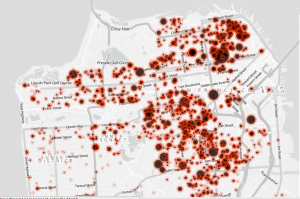
Harley’s observation about copyright is particularly prescient in the age of digital maps. The chapter on the Ethics of Cartography starts with a bit of doggerel about the enclosure of the British commons – “The law locks up both man and woman/Who steals thegoose from off the common/But lets the greater felon loose/Who steals the common from the goose.” Anticipating the arguments of Lessig and others, Harley opposes the assumption that maintaining proprietary map data should be considered an ethical responsibility of mapmakers, and contends instead that data about the physical world should be considered part of the intellectual “commons.”
The rise of digital geospatial applications creates new opportunities for popular creativity and protest, even as it creating new opportunities for commercialization and surveillance. In the chapter on ethics, Harley writes, with some exaggeration that “cartographers create a spatial panopticon.” Today, San Jose City Council Member and Mayoral Candidate Sam Liccardo’s proposal for the City to have access to private surveillance cameras for law enforcement purposes. That’s not even counting the use of mobile phone data for ubiquitous surveillance by the NSA and others. The panopticon is already here.
Google Maps, Yelp, and other commercially-sponsored geospatial apps brings advertising into every decision about and experience of navigating the world; and Google Glass offers to bring commercial information within one’s field of perception. In “The New Nature of Maps”, JB Harley was able to utilize the techniques of social theory to decipher ways in which “the map is not the territory.” When geospatial information appears as an overlay in one’s field of vision, it will become more difficult to critique.
For @peterme, I enjoyed the book in large part because of the many examples decoding maps across European and American history, and also because of the opportunity the book presents to reflect on changes in mapping since the book was written. I read the segments on theory fairly lightly with the background knowledge that this was an argument that had since been won; readers who are more interested in the nuances of philosophy may get something different out of the book. Recommended for people interested in the subject matter.
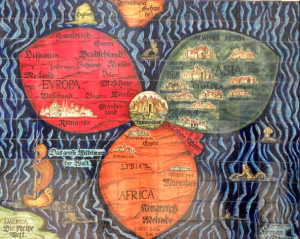
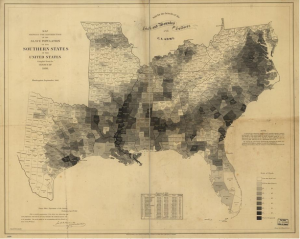
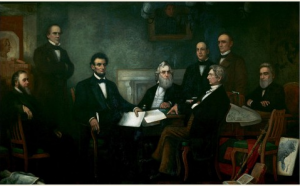
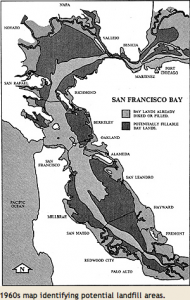
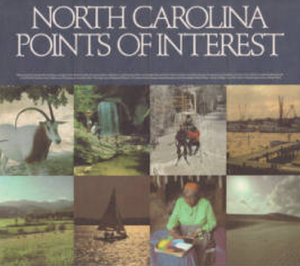
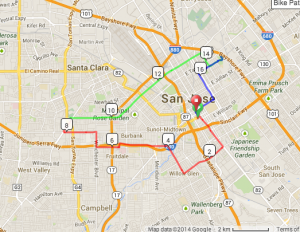
Adina, I enjoyed this so much! Thanks for introducing us to a book we’re definitely going to want to read. I am currently involved in a political campaign in which the use of maps is critically important, so that added to my interest. And I wonder what he would think about the ways that digital maps can interface with other methods of organizing and presenting information to create multimodal ways to understand the physical and social world.
Exellent point. Especially since an important use of early modern maps was for military campaigns, and those maps were top-secret, available only to kings, princes, and military commanders. Computer technology made voter and geographic data accessible for the fundamentally nonviolent purpose of election campaigns starting in the 1980s. More recently, client-server computing, the internet, desktop and mobile devices have made mapping applications accessible to even the most local city council elections in small cities. The visualization and analysis tools are integrated with walk lists and organizing applications.
Here is an article I just found on the history of US voter file data: http://www.campaignsandelections.com/magazine/us-edition/371892/evolution-of-the-voter-file.thtml